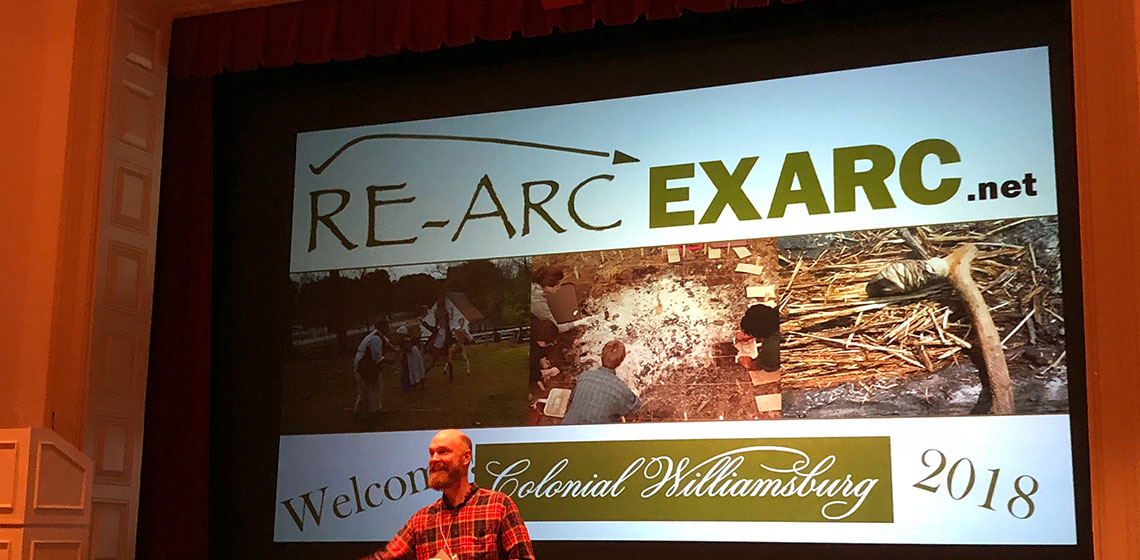
The 8th annual Reconstructive and Experimental Archaeology Conference hosted by EXARC drew speakers and participants from many parts of the world. The REARC conference was once again hosted by Colonial Williamsburg in Virginia, from October 18-20th. Friday was reserved for the presentation of papers, by students and researchers alike, demonstrating the wealth of information and practical skills available within the EXARC community. Saturday was filled with numerous demonstrations in which the conference attendees could participate and museum visitors could watch and learn.
The presented papers ranged from practical recreations like bird bone flute making and weaving reed beads, duplicating pottery impressions and the use of recreated objects, were Ötzi’s tools used for hunting or for warfare, and the function of experimental archaeology within different types of classrooms. Some researchers presented a follow up on previous papers, like Neil Peterson with his ongoing Viking bead furnace project. Others might look for resources not yet found – the joy of Caitlin Gaffney after finding a possible source for a reproduction medieval knife to carve her bone flutes was absolutely contagious. And some were looking to network: David Spence asked for additional projects for his Experimental Archaeology in High School and left with numerous contacts and suggestions. Each and every paper had some unique view, some unusual bit of information – as the practical aspects of experimental archaeology requires a more interdisciplinary approach than traditional academics, conferences like REARC are essential. You just never know from what discipline or from which subject the answer to the question you did not even realize you had could come. I personally was amazed to find that the gist of my paper, to not take words at their literal modern definition, was independently repeated in another paper – to have my initial interpretation validated via an independent source right then and there.
The keynote speaker for this year was Bill Schindler, an experimental archaeologist with Washington College and part of the Eastern Shore Food Labs. His quite engaging presentation on “Fusion: ancestral diets, modern culinary techniques” and experimental archaeology was well received, and left the audience with a number of questions to think on. This paper was perfect for our younger generation, our students, as they are now growing up in an environment that might be more hostile to them than they would surmise, and where their chosen area of research, experimental archaeology, could help shed light on where to go from here. The connection between human biology and our diet, and the impact industrialization has had on our health to the point where humans and their pets can be both obese and malnourished, is not only fascinating from an academic point of view, but relevant to the survival of our species.
This year’s demonstrations were two-part: the practice of throwing atlatl and the shooting of character bows, combined with the technique of smelting and casting bronze and making Viking era glass beads. Unfortunately, while the weather was absolutely gorgeous on Friday, by the time Saturday came around it had changed to intermittent drizzle and rain. But that did not stop us from having a go at each of the stations, and appreciate the added value of tent coverings at the metallurgy and flame-work areas. While I would have loved to try Ötzi’s replica bow as initially intended, Manuel Lizarralde did not feel comfortable to have it out in the soaking rain as it was not yet waterproof. I did get to shoot a fire-hardened black locust Native American self bow, weatherproofed with bear grease, and even hit the targets centre. Conference host Tim Messner enjoyed the primitive tattoo kit and extant stone tools that Talon Silverhorn, Native American interpreter, brought to share – and almost talked him into a tattoo demo on the spot.
Finally, before packing up, Fergus Milton did a quick demonstration of cuttlefish casting for David Spence with a view to showing to his highschool students. He used some tin he had on hand, and as it had a lower melting temperature than the bronze, it quickly became molten and he was able to show how the porous nature of the cuttlefish bone lends itself well to making a quick mold. It takes a good amount of detail from the master used to press into the material, and feels a bit like a dense, fine Styrofoam when pushing a metal object in to make an impression.
To cap off this wonderful experience, the resident founders at Williamsburg had invited Fergus Milton for a special bronze casting demonstration Sunday morning at their shop. To experience the prehistoric process, so closely followed by the much more refined methods of the 18 th century Geddy Foundry, was an appropriate ending to an otherwise perfect immersive weekend of reconstructive and experimental archaeology. We are ready to come back for more next year!